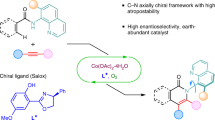Abstract
A series of novel N,O-type chiral ligands derived from enantiopure inherently chiral calix[4]arenes containing quinolin-2-yl-methanol moiety in the cone or partial-cone conformation have been synthesized and characterized. Moreover, they have been applied to the catalytic asymmetric addition of diethylzinc to benzaldehyde, which represents the first example that the inherently chiral calixarene can be used as the chiral ligands for the catalytic asymmetric synthesis.
Similar content being viewed by others
References
Gutsche C D. In: Calixarenes Revisited, Monographs in Supramolecular Chemistry. Stoddart J F Ed. Royal Society of Chemistry: London, 1998
Asfari Z, Böhmer V, Harrowfield J, Vicens J, Eds. Calixarenes 2001. Dordrecht, the Netherlands: Kluwer Academic Publishers, 2001
No K H, Gutsche C D. Calixarenes. 8. Short, stepwise synthesis of p-phenylcalix[]arene, p-phenyl-p-tert-butylcalix[4]arene, and derived products. J Org Chem, 1982, 47: 2713–2719
Jin T, Monde K. Synthesis and optical resolution of a fluorescent chiral calix[4]arene with two pyrene moieties forming an intramolecular excimer. J Chem Soc, Chem Commun, 1998, 1357–1358
Dieleman C., Steyer S, Jeunesse C, Matt D. Diphosphines based on an inherently chiral calix[4]arene scaffold: Synthesis and use in enantioselective catalysis. J Chem Soc, Dalton Trans, 2001, 2508–2517
Yakovenko A V, Boyko V I, Danylyuk O, Suwinska K, Lipkowski J, Kalchenko V I. Diastereoselective lower rim (1S)-comphorsulfonylation as the shortest way to the inherently chiral calix[4]arene. Org Lett, 2007, 9: 1183–1185
Shirakawa S, Moriyama A, Shimizu S. Design of a novel inherently chiral calix[4]arene for chiral molecular recognition. Org Lett, 2007, 9: 3117–3119
Cao Y D, Luo J, Zheng Q Y, Chen C F, Wang M X, Huang Z T. Preparation of both antipodes of enantiopure inherently chiral calix[4]crowns. J Org Chem, 2004, 69: 206–208
Luo J, Zheng Q Y, Chen C F, Huang Z T. Synthesis and optical resolution of a series of inherently chiral calix[4]crowns with cone and partial cone conformations. Chem Eur J, 2005, 11: 5917–5928
Luo J, Zheng Q Y, Chen C F, Huang Z T. Facile synthesis and optical resolution of inherently chiral fluorescent calix[4]crowns: Enantioselective recognition towards chiral leucinol. Tetrahedron, 2005, 61: 8517–8528
Li S Y, Zheng Q Y, Chen C F, Huang Z T. Preparation of enantiopure inherently chiral calix[5]arenes. Tetrahedron: Asymmetry, 2005, 16: 641–645
Narumi F, Hattori T, Matsumura N, Onodera T, Katagiri H, Kabuto C, Kameyama H, Miyano S. Synthesis of an inherently chiral O,O′-bridged thiacalix[4]crowncarboxylic acid and its application to a chiral solvating agent. Tetrahedron, 2004, 60: 7827–7833
Narumi F, Hattori T, Yamabuki W, Kabuto C, Kameyama H. Resolution of inherently chiral anti-O,O′-dialkylated calix[4]arenes and determination of their absolute stereochemistries by CD and X-ray methods. Tetrahedron: Asymmetry, 2005, 16: 793–800
Boyko V I, Shivanyuk A, Pyrozhenko V V, Zubatyuk R I, Shishkin O V, Kalchenko V I. A stereoselective synthesis of asymmetrically substituted calix[4]arenecarbamates. Tetrahedron Lett, 2006, 47: 7775–7778
Xu Z X, Zhang C, Zheng Q Y, Chen C F, Huang Z T. A new approach to enantiopure inherently chiral calix[4]arenes: Determination of their absolute configurations. Org Lett, 2007, 9: 4447–4450
Xu Z X, Zhang C, Yang Y, Chen C F, Huang Z T. Effective nonenzymatic kinetic resolution of racemic m-nitro-substituted inherently chiral aminocalix[4]arenes. Org Lett, 2008, 10: 477–479
Xu Z X, Li G K, Chen C F, Huang Z T. Inherently chiral calix[4]arene-based bifunctional organocatalysts for enantioselective aldol reactions. Tetrahedron, 2008, 64: 8668–8675
Mao R, Zheng Q Y, Chen C F, Huang Z T. Efficient syntheses and resolutions of inherently chiral calix[4]quinolines in the cone and partial-cone conformation. J Org Chem, 2005, 70: 7662–7671
Ruzziconi R, Piermatti O, Ricci G, Vinci D. (S)-(−)-and (R)-(+)-4-methyl-2-hydroxymethyl[2]paracyclo-[2](5,8)quinolinophane: Novel N,O-planar chiral catalysts for the enantioselective addition of diethylzinc to aldehydes. Synlett, 2002, 747–750
Pu L, Yu H B. Catalytic asymmetric organozinc additions to carbonyl compounds. Chem Rev, 2001, 101: 757–824
Author information
Authors and Affiliations
Corresponding author
Additional information
Supported by the National Natural Science Foundation of China (Grant Nos. 20625206 & 20372064), the National Basic Research Project (Grant Nos. 2007CB808000 & 2008CB617501), and the Chinese Academy of Sciences
Rights and permissions
About this article
Cite this article
Miao, R., Xu, Z., Huang, Z. et al. Enantiopure inherently chiral calix[4]arene derivatives containing quinolin-2-yl-methanol moiety: Synthesis and application in the catalytic asymmetric addition of diethylzinc to benzaldehyde. Sci. China Ser. B-Chem. 52, 505–512 (2009). https://doi.org/10.1007/s11426-009-0002-6
Received:
Accepted:
Published:
Issue Date:
DOI: https://doi.org/10.1007/s11426-009-0002-6




